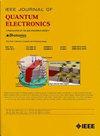Enhanced Spectrally Selective Terahertz Detection in a Photo-Thermoelectric Graphene Detector With Dual Nano-Grating Gates
IF 2.1
3区 工程技术
Q3 ENGINEERING, ELECTRICAL & ELECTRONIC
引用次数: 0
Abstract
We introduce a high-performance terahertz detector based on the photo-thermoelectric effect (PTE) in graphene. Our study outlines a novel approach to enhance terahertz detection through a photodetector that employs a hybrid structure. This structure combines the localized surface plasmon resonance of dual grating gates with the resonant modes of a Fabry-Perot cavity configuration, facilitating a strong interaction between terahertz light and the active graphene layer, thereby improving light absorption. Our numerical investigation reveals frequency selectivity within the terahertz absorptance spectrum for incident waves with transverse magnetic polarization, leading to near-perfect absorptance of graphene. This substantial absorption creates an amplified thermal gradient across the graphene channel due to localized heat generation from terahertz wave absorption. The detector’s absorption characteristics can be adjusted by altering geometrical parameters and tuning two gate voltages. Furthermore, incorporating dual grating gates to create a pn-junction leads to a non-uniform Seebeck coefficient along the channel, enhancing the generated voltage. At a resonant frequency of 1.6 THz, the detector demonstrates a responsivity of 1.26 V/W and a noise-equivalent power (NEP) of带双纳米光栅的光热电石墨烯探测器的增强型光谱选择性太赫兹探测功能
我们介绍了一种基于石墨烯光热电效应(PTE)的高性能太赫兹探测器。我们的研究概述了一种通过采用混合结构的光电探测器增强太赫兹检测的新方法。这种结构将双光栅栅极的局部表面等离子体共振与法布里-珀罗腔配置的共振模式相结合,促进了太赫兹光与活性石墨烯层之间的强烈相互作用,从而改善了光吸收。我们的数值研究揭示了太赫兹吸收光谱对横向磁极化入射波的频率选择性,从而使石墨烯具有近乎完美的吸收能力。由于太赫兹波吸收产生的局部热量,这种大量吸收在石墨烯通道上形成了一个放大的热梯度。探测器的吸收特性可以通过改变几何参数和调整两个栅极电压来调整。此外,采用双光栅栅极创建 pn 结会导致通道沿线的塞贝克系数不均匀,从而提高产生的电压。在 1.6 太赫兹的谐振频率下,该探测器在室温条件下,在两个光栅栅极±0.2 V 的低电压偏置下,响应率为 1.26 V/W,噪声等效功率(NEP)为 5.2 \mathrm {nW}/\sqrt {\mathrm {Hz}}$。
本文章由计算机程序翻译,如有差异,请以英文原文为准。
求助全文
约1分钟内获得全文
求助全文
来源期刊

IEEE Journal of Quantum Electronics
工程技术-工程:电子与电气
CiteScore
4.70
自引率
4.00%
发文量
99
审稿时长
3.0 months
期刊介绍:
The IEEE Journal of Quantum Electronics is dedicated to the publication of manuscripts reporting novel experimental or theoretical results in the broad field of the science and technology of quantum electronics. The Journal comprises original contributions, both regular papers and letters, describing significant advances in the understanding of quantum electronics phenomena or the demonstration of new devices, systems, or applications. Manuscripts reporting new developments in systems and applications must emphasize quantum electronics principles or devices. The scope of JQE encompasses the generation, propagation, detection, and application of coherent electromagnetic radiation having wavelengths below one millimeter (i.e., in the submillimeter, infrared, visible, ultraviolet, etc., regions). Whether the focus of a manuscript is a quantum-electronic device or phenomenon, the critical factor in the editorial review of a manuscript is the potential impact of the results presented on continuing research in the field or on advancing the technological base of quantum electronics.
 求助内容:
求助内容: 应助结果提醒方式:
应助结果提醒方式:


